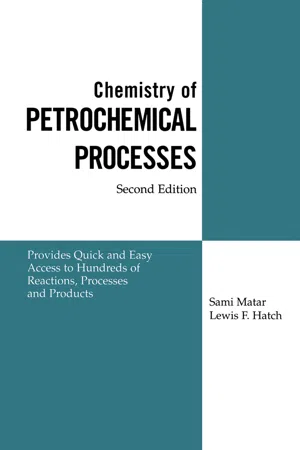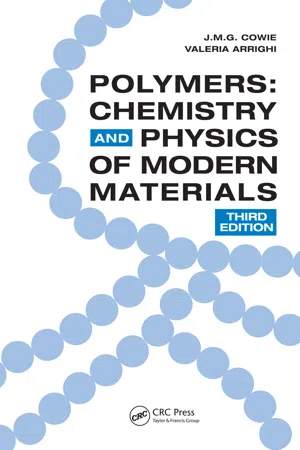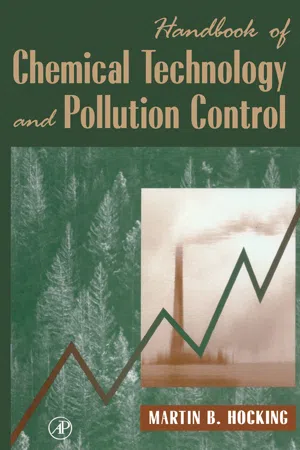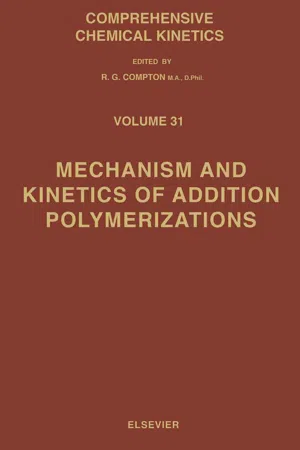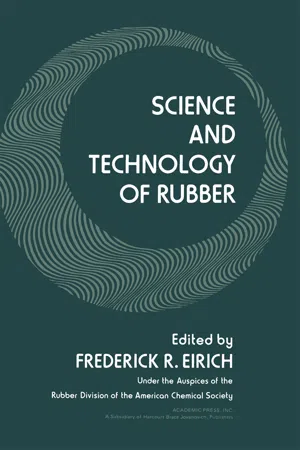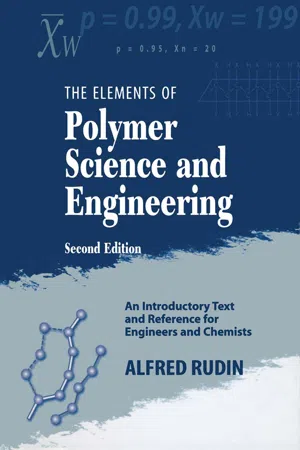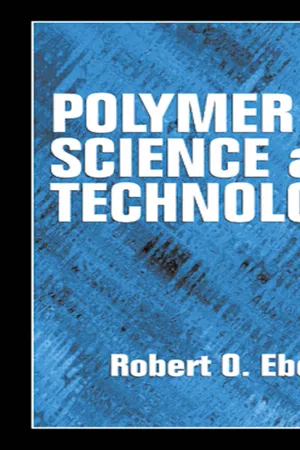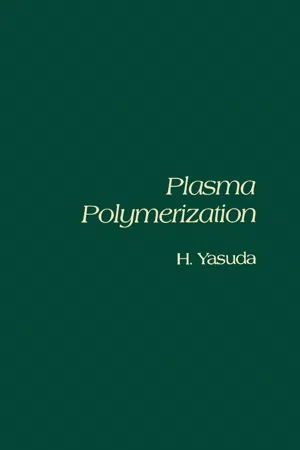Chemistry
Addition Polymerization
Addition polymerization is a process in which monomers join together to form a polymer without the formation of any by-products. This reaction occurs through the repeated addition of monomers to a growing polymer chain, typically initiated by a catalyst or initiator. The resulting polymer has a high molecular weight and a linear structure.
Written by Perlego with AI-assistance
Related key terms
1 of 5
11 Key excerpts on "Addition Polymerization"
- eBook - PDF
- Sami Matar Ph.D., Lewis F. Hatch Ph.D., Sami Matar, Ph.D., Lewis F. Hatch, Ph.D.(Authors)
- 2001(Publication Date)
- Gulf Professional Publishing(Publisher)
CHAPTER ELEVEN Polymerization INTRODUCTION Polymerization is a reaction in which chain-like macromolecules are formed by combining small molecules (monomers). Monomers are the building blocks of these large molecules called polymers. One natural polymer is cellulose (the most abundant organic compound on earth), a molecule made of many simple glucose units (monomers) joined together through a glycoside linkage. ~ Proteins, the material of life, are polypeptides made of ~-amino acids attached by an amide 0 II --(- CNH-)-- linkage. The polymer industry dates back to the 19th century, when natural polymers, such as cotton, were modified by chemical treatment to pro- duce artificial silk (rayon). Work on synthetic polymers did not start until the beginning of the 20th century. In 1909, L. H. Baekeland prepared the first synthetic polymeric material using a condensation reaction between formaldehyde and phenol. Currently, these polymers serve as important thermosetting plastics (phenol formaldehyde resins). Since Baekeland's discovery, many polymers have been synthesized and marketed. Many modern commercial products (plastics, fibers, rubber) derive from poly- mers. The huge polymer market directly results from extensive work in synthetic organic compounds and catalysts. Ziegler's discovery of a coordination catalyst in the titanium family paved the road for synthe- sizing many stereoregular polymers with improved properties. This chapter reviews the chemistry involved in the synthesis of polymers. 301 302 Chemistry of Petrochemical Processes MONOMERS, POLYMERS, AND COPOLYMERS A monomer is a reactive molecule that has at least one functional group (e.g.-OH,-COOH,-NH2,-C=C-). Monomers may add to them- selves as in the case of ethylene or may react with other monomers hav- ing different functionalities. A monomer initiated or catalyzed with a specific catalyst polymerizes and forms a macromolecule~a polymer. - eBook - PDF
- John J. McKetta Jr(Author)
- 1993(Publication Date)
- CRC Press(Publisher)
892 Polymerization Polymerization Introduction Polymerization conditions and processes often differ greatly for the pro-duction of different high polymers or even in some cases the same polymers. Careful control of the operating conditions is needed in all cases to obtain high-quality products in an economical manner. The high polymers consid-ered here are those that have high molecular weights and that find uses as plastics, elastomers (or synthetic rubbers), synthetic fibers, adhesives, and surface coatings, such as paints or varnishes. The operating conditions for the production of a polymer affect the rates of polymerization and also at least some of the following structural features of the polymer molecules: molecular weight, cross-linking, linearity of the molecule, branching, and stereospecificity. These features have a major effect on the morphology or packing abilities of the molecules and hence on the physical properties of the polymers. The relationship between struc-tural features of the molecules and physical properties is considered in more detail later. Chemistry of Polymerization Based on the reactants used to produce the polymers, polymerizations are divided into two broad categories: polycondensations and addition polym-erizations. Polycondensation Polyesters, polyamides (or nylons), polyurethanes, phenolics, urea resins, and epoxies are important examples of polycondensations. Often but not always, two or more reactants are employed, and the average functionality of the reactants must be at least two. A functionality of one is defined as the ability of a molecule to form a single chemical bond with another mol-ecule. With a functionality of two, chemical bonds can be obtained with two other molecules. In the latter case, polymerization can occur and the polymer chain can increase in length (and molecular weight), forming so-called linear molecules. - eBook - PDF
Polymers
Chemistry and Physics of Modern Materials, Third Edition
- J.M.G. Cowie, Valeria Arrighi(Authors)
- 2007(Publication Date)
- CRC Press(Publisher)
57 3 Free-Radical Addition Polymerization 3.1 Addition Polymerization In step-growth polymerization reactions it is often necessary to use multifunctional monomers if polymers with high molar masses are to be formed; this is not the case when addition reactions are employed. Long chains are readily obtained from mono-mers such as vinylidene compounds with the general structure CH 2 = CR 1 R 2 . These are bifunctional units, where the special reactivity of π -bonds in the carbon to carbon double bond makes them susceptible to rearrangement if activated by free-radical or ionic initiators. The active center created by this reaction then propagates a kinetic chain, which leads to the formation of a single macromolecule whose growth is stopped when the active center is neutralized by a termination reaction. The complete polymerization proceeds in three distinct stages: (1) initiation , when the active center which acts as a chain carrier is created; (2) propagation , involving growth of the macromolecular chain by a kinetic chain mechanism and characterized by a long sequence of identical events, namely the repeated addition of a monomer to the growing chain; and (3) termination , whereby the kinetic chain is brought to a halt by the neutralization or transfer of the active center. Typically the polymer formed has the same chemical composition as the monomer, i.e., each unit in the chain is a complete monomer, and not a residue as in most step-growth reactions. 3.2 CHOICE OF INITIATORS A variety of chain initiators is available to the polymer chemist. These fall into three general categories: free radical , cationic , and anionic . The choice of the most appropriate one depends largely on the groups R 1 and R 2 in the monomer and their effects on the double bond. This arises from the ability of the alkene π -bond to react in a different way with each initiator species to produce either heterolytic (I) or homolytic (II) fi ssion. - Martin B. B. Hocking(Author)
- 2013(Publication Date)
- Academic Press(Publisher)
Chain reaction polymerization involves use of a monomer with at least one carbon-carbon or carbon-heteroatom double bond. The double bond rep-resents a masked functionality of two, which can form new single bonds link-ing monomer units on interaction with an initiator, which could be a radical species or a charged molecule or atom. This step represents the first of three distinct kinetic divisions recognized for chain reaction polymerization: initia-tion, propagation, and termination. For a free radical initiated process with a monomer such as ethylene, the three stages can be represented as follows (Eq. 22.1-22.6). Species suitable for initiation of a free radical promoted process are normally generated by the homolytic dissociation of weak bonds of a precursor by heat or light. 712 22 ADDITION (CHAIN REACTION) POLYMER THEORY H ^ l TABLE 22.3 Contrasting Characteristics of Condensation and Chain Reaction Polymerization Characteristic Condensation (step-reaction) polymerization Chain reaction (vinyl-type) polymerization Chain growth Process involved Rate Product DP* Heterogeneity index, = p By reactions between monomers, oligomers, and polymers Usual loss of small molecule Same reaction involved with all reacting species present No initiator required (catalyst sometimes) Monomer consumed early in polymerization; molecular wt. increases slowly Decreases steadily as polymerization proceeds Low to moderate for linear product ca. 2 Only by monomer addition to initiating radicals Whole monomer incorporated Initiation, propagation, and termination mechanisms different Suitable radical, or charged ( + , or — ) initiator required Only monomer and high polymer present; each polymer molecule forms very rapidly Increases initially, then stays nearly constant until monomer consumed High, to very high ca. 2 b Degree of polymerization, or X n . Except for anionic living polymerizations where the value is about 1; see Section 22.5.- M. Kucera(Author)
- 1991(Publication Date)
- Elsevier Science(Publisher)
Nevertheless, both chain types grow by stepwise monomer addition to carboxonium or oxonium centres, respectively. The borderline between chain and step polyadditions has never been strictly defined. In fact it is mobile, and if the molar mass change with time is accepted as a criterion, this borderline is expected to change with the development of experimental methods. Polymerizations proceeding on the multiple bonds of monomers or by opening of their rings need not be classified in this way +. 4. Classification according to number of monomers The number of monomers and the manner of their alternation in the polymer permits the classification of polymerizations as homopolymerization and copolymerization. ’ As a process characterizing name, the term step polyaddition is preserved for cases where a monomer with multiple bonds is “copolymerizing” with saturated monomers. The formation of polyurethanes is an example of such a process n O=C=N-R-N=C=O + nHO-R‘-OH + + O=C=N-R-NH-C- -0-R‘-0-C-NH-R-NH-C- -0-R-OH. 0 [ 0 II 0 ‘I I . , Reactions of this type resemble polycondensations rather than polymerizations. The above example belongs to the group of polyreactions called migration polymerizations (the H atom migrates from 0 to N). Copolymerization is a variant of polymerization where macromolecules composed of two or more kinds of monomer are formed. According to the frequency of entry of various monomers into the chains, copolymers (and even the reactions by which they are formed) are sometimes more closely specified by special attributes. Thus copolymers may be unspecified, statisti- cal, random, periodic, alternating, block or graft. The building of copolymers even with an unspecified distribution of mon- omeric units in the macromolecules certainly obeys some rules. Either these rules are as yet unknow or else it remains unclear which of the known rules have been operating; this kind of copolymer is designated poly(M,-co- -M, ,..) [3] where MI, M,, M, ...- eBook - PDF
- Frederick R. Eirich(Author)
- 2012(Publication Date)
- Academic Press(Publisher)
2. POLYMERIZATION 25 II. Classification of Polymerization Reactions and Kinetic Considerations Historically polymers have been divided into two broad classes: condensa-tion polymers and addition polymers. For example, Flory [9, p. 37]* has de-fined these as follows: . . . condensation polymers, in which the molecular formula of the structural unit (or units) lacks certain atoms present in the monomer from which it is formed, or to which it may be degraded by chemicaj means, and addition polymers, in which the molecular formula of the structural unit (or units) is identical with that of the monomer from which the polymer is derived. Thus an example of a condensation polymer would be a polyester, formed by the condensation reaction between a glycol and a dicarboxylic acid (with the evolution of water), whereas an addition polymer is exemplified by polystyrene, formed by the self-addition of styrene monomers. Although these earlier definitions were based on the chain structure of the polymers, they were closely related, as just described, to the mode of formation as well. It soon became apparent that such a classification has serious short-comings, since so-called polycondensates could result from kk addition poly-merization reactions. Thus, for example. Nylon 6 is now synthesized by the ring-opening Addition Polymerization of caprolactam, and this process has a profound effect on the properties of the resulting polymer. This is, of course, due basically to the magnitude of the molecular weight of the final polymer. Since it is the extraordinarily large size of the macromolecules which leads to their unusual properties, it would be most sensible to classify polymerization reactions in accordance with the way in which they affect the molecular size and size distribution of the final product. On this basis, there appears to be only two basic processes whereby macromolecules are synthesized: (1) functional group polymerization, and (2) chain Addition Polymerization. - eBook - PDF
The Elements of Polymer Science and Engineering
An Introductory Text for Engineers and Chemists
- Alfred Rudin(Author)
- 2012(Publication Date)
- Academic Press(Publisher)
Chapter 5 Step-Growth Polymerizations 5.1 CONDENSATION AND ADDITION POLYMERS There are many possible ways to classify polymers. Each may be useful depending on the interests of the classifier. Examples include typing according to the source of the product (e.g., naturally occurring polymers, entirely synthetic macromolecules, or those derived by chemi-cal modification of naturally occurring polymers), chemical structure (e.g., polyolefin, polyamide, etc.), polymer texture during use (rubbery, glassy, partially crystalline), area of application (adhesive, fiber, etc.), and so on. An important classification divides macromolecules into addi-tion and condensation polymers. This distinction was made by W. H. Carothers [1], who invented nylon-6,6 and made many fundamental con-tributions to our knowledge and control of polymerizations. Carothers's classification into condensation and addition polymers is no longer valid for its intended purpose because of the many advances in technology in the half century since the idea was proposed. It is neverthe-less still deeply entrenched in current thinking, and it will be necessary for the reader to understand its current meaning in order to read the polymer literature with ease. In this section we shall review the original classifica-tion, show why it is no longer generally applicable, summarize the current accepted meaning of the terms addition and condensation 11 poly-mers, and then turn our attention to a useful, alternative classification which focuses on polymerization processes rather than the products of such processes. This line of reasoning takes us into a more detailed con-sideration of polymerizations in this and succeeding chapters. A condensation polymer is one in which the repeating unit lacks cer-tain atoms which were present in the monomer(s) from which the polymer was formed or to which it can be degraded by chemical means. Condensa-155 - eBook - PDF
Elements of Polymer Science & Engineering
An Introductory Text and Reference for Engineers and Chemists
- Alfred Rudin(Author)
- 1998(Publication Date)
- Academic Press(Publisher)
[An exception is polyformaldehyde (1-12), which is an addition polymer.] It will be clear from these examples that this classification is now somewhat arbitrary. Many authors still refer to addition and condensation polymers in their current, conventional sense, however, and it is therefore necessary for the informed reader to understand this usage. 5.2 STEPGROWTHAND CHAIN-GROWTH POLYMERIZATIONS A more useful distinction is based on polymerization mechanisms, rather than polymer structures [2]. Most polymerizations can be classified as step-growth or chain-growth processes. A few reactions possess some characteristics of both mechanisms but the great majority of polymer syntheses can be characterized conveniently into one class or the other. We will see later that the nature of the polymerization is very different in the two cases, and the general opera-tions required to produce high-molecular-weight polymers of good quality and in good yield are quite different for step-growth and chain-growth syntheses. The distinguishing features of step- and chain-growth mechanisms are listed below. A subsequent example is provided to illustrate the differences, which may not be entirely clear from this bald summary of the characteristics of each reaction type. The following features characterize step-growth polymerizations: 1. The growth of polymer molecules proceeds by a stepwise intermolecular reaction. Only one reaction type is involved in the polymerization. 2. Monomer units can react with each other or with polymers of any size. Polymer molecules grow over the course of the whole reaction, and such growth is in a series of fits and starts as the reactive end of a monomer or polymer encounters other species with which it can form a link. 3. The functional group on the end of a monomer is usually assumed to have the same reactivity as that on a polymer of any size. 5.2 Step-Growth and Chain-Growth Polymerizations 159 4. - eBook - PDF
- Robert O. Ebewele(Author)
- 2000(Publication Date)
- CRC Press(Publisher)
An example is the reaction between a dibasic acid and glycerol, which has two primary and one secondary hydroxyl groups (functionality of 3). A monomer that possesses such a functionality is referred to as a branch unit. Every reaction of such a molecule introduces a branch point for the development of the three-dimensional network. The portion of a polymer molecule lying between two branch points or a branch point and a chain end is called a chain section or segment. As polymerization proceeds many branch points are formed. Reaction between large molecules considerably increases the number of reaction groups per polymer chain. The size of the polymer molecules increases rapidly, culminating in the formation of a three-dimensional network polymer of infinite molecular weight. During this process, the viscosity of the reaction medium increases gradually at first and experiences a sudden and enormous increase just before the formation of the three-dimensional netwo rk (Figure 6.6). The reaction medium loses fluidity, and bubbles cease to rise through it. Gelation is said to have occurred at this point, which is referred to as the gel point. The sudden onset of gelation does not indicate that all the reactants have become bound together in the resulting three-dimensional network. Gelation marks the division of the reaction medium into an insoluble material called the gel and a portion still soluble in an appropriate solvent referred to as the sol. If polymerization is continued beyond the gel point, the gel fraction increases at the expense of the sol. As would be expected, at gelation there is a considerable depletion of individual molecules, and consequently the number-average molecular weight becomes very low. On the other hand, the weight-average molecular weight becomes infinite. - eBook - PDF
- H K Yasuda(Author)
- 2012(Publication Date)
- Academic Press(Publisher)
Free radical polymerization is perhaps the most thoroughly studied reaction among chain-growth polymerizations. Table 5.2 lists typical mono-mers that are polymerized by free radical polymerization on an industrial scale. The elementary reactions of free radical Addition Polymerization can be represented by using M for a monomer, I for an initiator, P for a polymer, A for a chain transfer agent, and the corresponding symbols with a dot for free radicals (R* is the starting free radical, produced by decomposition of the initiator): Initiation I 2 R -(5-10) R. + M M -(5-11) Propagation M + M M M -fc P (5-12) 5.2. ADDITIO N POLYMERIZATIO N 51 Tabl e 5.2 TYPICA L MONOMER S USE D FO R FRE E RADICA L POLYMERIZATIO N Monome r Structur e Monome r Structur e Ethylen e H 2 C = C H 2 Styren e H 2 C = C H 6 Vinyl chlorid e H 2 C = C H 1 CI Vinyliden e chlorid e H 2 C = C C l 2 Acrylonitril e H 2 C = C H 1 C N Vinyl acetat e H 2 C = C H 1 O C O C H 3 Methy l methacrylat e C H 3 H C = C ( C O O C H 3 Methacrylat e H 2 C = C H 1— CO O CH 3 Termination Recombinatio n M m - + M - P m + n (5-13) Disproportionatio n M M » + M « ^ P m + P (5-14) Chain transfer M . + A P n + A-(5-15) A-+ M -^-> M-+ A (5-16) In the study of polymerization kinetics, it is generally assumed that (1) the reactivity of the growing chain radical is independent of the chain length, (2) the kinetic chain length (number of consecutive steps) is long enough, and (3) the concentration of growing chain radicals remains constant during the polymerization (steady-state polymerization). Many experimental data in-dicate that these assumptions are well justified in most cases. With these assumptions, Rate of polymerization = — d[M]/dt = (2fc d /) 1 / 2 fc p (2fc t )-1 / 2 [I] 1 / 2 [M] (5-17) = J R i 1 / 2 R p (2 /c t r 1 / 2 [M], (5-18) where the efficiency factor / is the fraction of free radicals formed by the decomposition of an initiator that react with monomer, that is, / is equal to - eBook - PDF
- James E. Mark, Burak Erman(Authors)
- 2011(Publication Date)
- Academic Press(Publisher)
This new parameter is most impor-tant, since it controls the composition of the copolymer. Systems involv-ing more than two monomers are difficult to resolve in this respect, but it has been found possible to treat the case of a pair of monomers with relative ease [91, 93–95]. In the chain Addition Polymerization of two monomers, regardless of the mechanism involved , the growing chain always must make a choice of react-ing with one of the two monomers. Furthermore, there are two kinds of growing chains, depending on which type of monomer unit occupies the growing end. Thus, four types of propagation steps can be written as follows for any chain copolymerization of two monomers assuming that the reactiv-ity of the chain end depends only on the chain end monomer unit (terminal model [89]): (31) (32) (33) (34) M M M 2 1 1 21 * * + æ Æ ææ k M M M 2 2 2 22 * * + æ Æ ææ k M M M 1 2 2 12 * * + æ Æ ææ k M M M 1 1 1 11 * * + æ Æ ææ k 2 Polymerization: Elastomer Synthesis 55 where M 1 * and M 1 refer to the growing chain and the monomer, respectively, as before, while the subscripts refer to the two kinds of monomer in the mixture. It can be seen that these four propagation reactions lead to four prop-agation rate constants, as shown. Hence the rate of consumption of each monomer may be expressed by the following equations: (35) (36) Since it is the relative rate of consumption of the two monomers which will decide the composition of the chain, it can be expressed by dividing Eq. (35) by Eq. (36) leading to Eq. (37). (37) It is obvious at once that Eq. (37) is quite intractable for direct use. However, it is possible to simplify it considerably by utilizing the “steady-state” treatment, analogous to the one previously described. This is done by assuming the rate of Eq. ( 32 ) to be equal to that of Eq. ( 34 ), and this leads to the equivalence which, when inserted into Eq.
Index pages curate the most relevant extracts from our library of academic textbooks. They’ve been created using an in-house natural language model (NLM), each adding context and meaning to key research topics.
